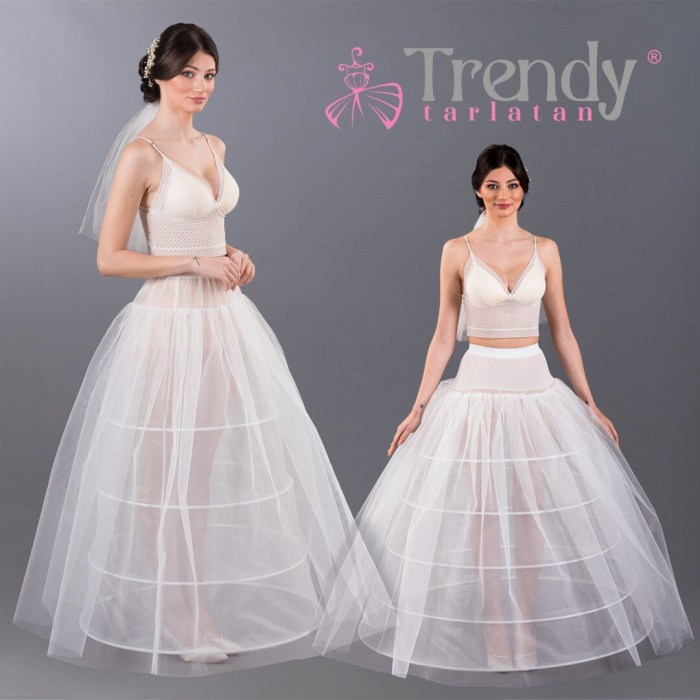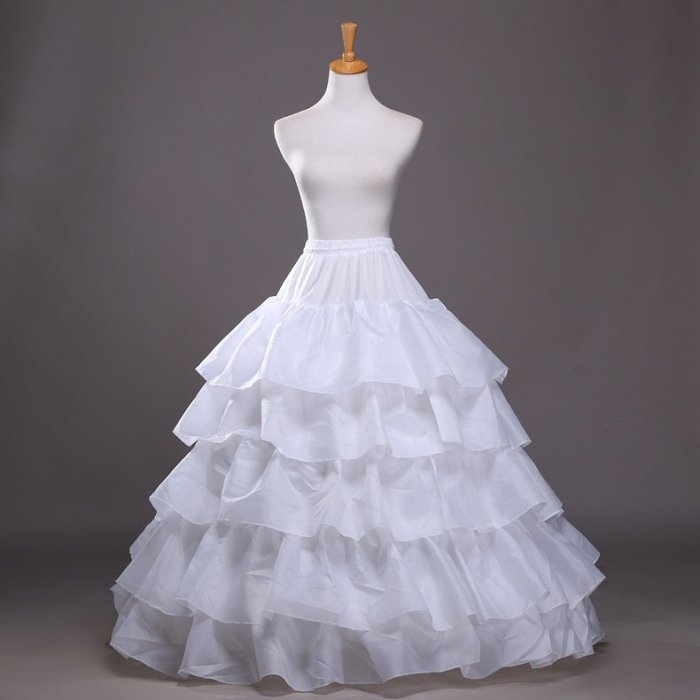Types of Petticoats for Wedding Dresses
Petticoat for wedding dress – Selecting the right petticoat is crucial for achieving the desired silhouette and fullness of your wedding gown. Different fabrics and styles offer varying degrees of volume and drape, impacting the overall look. Understanding these options allows for a perfect pairing of petticoat and dress.
Petticoat Fabrics and Their Properties
Several fabrics contribute to the unique properties of wedding petticoats. Tulle, a sheer netting, provides substantial volume with a soft, ethereal drape, ideal for creating a romantic, airy look. Organza, slightly stiffer than tulle, offers more structured volume and a crisp, clean silhouette. Satin, a smooth, luxurious fabric, provides a sleek, elegant foundation, offering less volume but a beautiful sheen that can subtly enhance the gown’s fabric.
Petticoat Styles and Their Silhouettes
The style of the petticoat significantly influences the final shape of the wedding dress. Three primary styles are commonly used: A-line, circle, and half-circle. An A-line petticoat creates a gently flared shape, suitable for dresses needing subtle volume. A circle petticoat, cut in a full circle, provides maximum volume and a dramatic, full skirt. A half-circle petticoat offers a balance between the two, providing good volume without being overly dramatic.
Matching Petticoats to Wedding Dress Styles
The choice of petticoat should complement the style of the wedding dress. A ballgown, for instance, benefits from a circle or half-circle petticoat for maximum fullness. A mermaid gown might require a shorter, less voluminous petticoat to maintain its form-fitting silhouette. Sheath dresses might only need a simple underskirt for smoothing.
| Dress Style | Recommended Petticoat Style | Fabric Suggestion | Volume Level |
|---|---|---|---|
| Ballgown | Circle or Half-circle | Tulle or Organza | High |
| A-line | A-line or Half-circle | Tulle | Medium |
| Mermaid | Short A-line or underskirt | Satin or lightweight lining | Low |
| Sheath | Underslip or short petticoat | Satin or lightweight lining | Very Low |
Choosing the Right Petticoat Length and Volume: Petticoat For Wedding Dress
The length and volume of the petticoat directly impact the overall look of the wedding dress. Careful consideration of these factors ensures the gown falls and drapes as intended. A properly chosen petticoat can enhance the design of the wedding dress, while an improperly chosen one can detract from it.
Petticoat Length and Its Effect on the Wedding Dress
The length of the petticoat should ideally be slightly shorter than the hem of the wedding dress to prevent it from showing. A longer petticoat can create unwanted bulk or distortion, while a shorter one might not provide enough support. The length should also consider the train length; a longer train often necessitates a longer petticoat to maintain its shape and fullness.
Petticoat Volume and Gown Fullness

Source: etsystatic.com
The volume of the petticoat directly correlates to the desired fullness of the gown. A larger volume creates a more dramatic, full skirt, whereas a smaller volume results in a more streamlined silhouette. The fabric choice also plays a role; a stiffer fabric like organza will create more volume than a softer fabric like tulle.
Petticoat Length and Volume Guide for Different Train Lengths
- Chapel Train: Petticoat length should be approximately 1-2 inches shorter than the dress hem. Volume should be medium to high, depending on the desired fullness.
- Cathedral Train: Petticoat length should be at least the same length as the train, possibly slightly longer. High volume is recommended to support the weight and fullness of the train.
- Sweep Train: Petticoat length should be slightly shorter than the dress hem. Medium volume is generally sufficient.
- No Train: Petticoat length should be a few inches shorter than the dress hem. Volume can be adjusted to the desired fullness of the skirt.
Petticoat Construction and Details
The construction of a petticoat influences its durability, comfort, and overall appearance. Careful attention to seams, hems, and potential embellishments can elevate a simple petticoat into a beautiful and functional undergarment. Understanding construction techniques allows for informed choices when purchasing or creating a petticoat.
Petticoat Construction Techniques
Petticoats are typically constructed using simple seams, such as French seams for a clean, professional finish. The hem is often double-stitched for durability. Embellishments like lace, ribbon, or even delicate beading can be added for a touch of elegance or personality. The choice of seam and hem finishing impacts the durability and longevity of the garment. French seams, for example, are stronger and less likely to unravel than simple seams.
Construction Methods and Their Impact, Petticoat for wedding dress
Using high-quality materials and precise construction methods ensures a comfortable and long-lasting petticoat. Strong seams and a well-finished hem prevent fraying and tearing, extending the life of the garment. Careful consideration of fabric weight and drape during construction ensures the petticoat provides the desired volume and support without being too bulky or uncomfortable.
A Unique Petticoat Design
Imagine a petticoat constructed from layers of ivory tulle, each layer progressively shorter, creating a cascading effect. Delicate ivory lace is strategically placed along the hemline of each layer, adding a subtle touch of elegance. The layers are joined using French seams, ensuring a smooth, invisible finish. The waistband is made from a soft satin ribbon, providing comfort and a touch of luxury.
Styling Petticoats with Wedding Dresses
Styling a petticoat effectively complements the wedding dress, enhancing its silhouette and overall aesthetic. The correct petticoat can transform the look of the gown, creating various styles ranging from romantic and classic to modern and contemporary.
Selecting a Petticoat to Complement the Wedding Dress

Source: ecrater.com
Choosing the right petticoat for your wedding dress is crucial for achieving the desired silhouette. The volume and length of the petticoat can significantly impact the overall look, and a similar consideration applies when selecting a dress for a beach wedding guest. For a relaxed yet elegant appearance, consider the options available in maxi dresses to wear to a beach wedding , which offer a breezy and comfortable alternative.
Ultimately, the right undergarments, like the perfect petticoat, are just as important as the dress itself.
The color and fabric of the petticoat should ideally complement the wedding dress. A white or ivory petticoat is a safe choice for most dresses. However, a colored petticoat can be used to subtly enhance the color scheme or create a unique effect. The fabric of the petticoat should also be considered; a stiff fabric will create more volume than a softer fabric.
Styling Petticoats for Different Looks
- Romantic: A tulle petticoat with lace trim creates a soft, ethereal look.
- Classic: A satin petticoat provides a sleek, elegant foundation.
- Modern: A structured organza petticoat with clean lines offers a contemporary feel.
Layering Petticoats for Enhanced Volume and Shape
- Start with a base layer, such as a slip or a simple petticoat for smoothing.
- Add a second layer, such as a half-circle or A-line petticoat, for additional volume.
- For maximum volume, add a third layer, such as a full circle petticoat. Ensure each layer is slightly shorter than the one above to prevent bunching.
Care and Maintenance of Wedding Petticoats
Proper care and maintenance ensure the longevity and beauty of your wedding petticoat. Understanding cleaning techniques and addressing common issues will help preserve this important garment for years to come.
Cleaning and Storage Techniques
Most petticoats can be hand-washed in cold water with a mild detergent. Always check the care label before cleaning. After washing, gently squeeze out excess water and lay flat to dry. Avoid direct sunlight or heat. Store the petticoat in a clean, dry place, ideally in a garment bag to protect it from dust and damage.
Addressing Common Petticoat Issues
Snags can be carefully repaired using a needle and thread. Stains should be treated promptly using a stain remover appropriate for the fabric. Small tears can be mended using an invisible stitch. For significant damage, consult a professional dry cleaner or seamstress.
Repairing Minor Damage
Minor snags can often be repaired by gently pulling the loose threads back into place. Small holes can be mended using a needle and thread, matching the thread color to the petticoat as closely as possible. For more complex repairs, it is best to consult a professional seamstress.
Budget-Friendly Petticoat Options
Creating a budget-friendly petticoat is achievable through DIY methods or by exploring cost-effective alternatives to traditional petticoats. Careful planning and selection of materials can significantly reduce costs without compromising quality or appearance.
DIY Petticoat Materials and Methods
Affordable materials such as inexpensive tulle, cotton fabric, or even repurposed materials can be used to create a DIY petticoat. Basic sewing skills are required, but the process is relatively straightforward. Online tutorials and patterns can provide guidance.
Ready-Made vs. DIY Petticoat: Cost Comparison
| Factor | Ready-Made Petticoat | DIY Petticoat | Notes |
|---|---|---|---|
| Cost | Varies widely, from affordable to expensive | Dependent on materials and time invested; can be significantly cheaper | Consider time value when comparing costs |
| Quality | Generally high, especially for higher-priced options | Varies depending on materials and sewing skills | Requires skill for high-quality DIY |
| Customization | Limited customization options | High degree of customization | DIY offers greater control over design and fit |
| Time | Immediately available | Requires time for material sourcing, pattern creation, and sewing | Factor in time commitment for DIY projects |
Alternative Solutions for Achieving Volume
Several alternatives can achieve similar volume without using a traditional petticoat. A well-structured slip can provide some fullness. Multiple layers of fabric in the wedding dress itself can also contribute to the desired silhouette. In some cases, strategically placed boning or crinolines within the gown can achieve a similar effect.
FAQs
Can I wear a petticoat under a slim-fitting wedding dress?
Yes, but choose a slimmer style like a half-slip or a very lightweight petticoat to avoid adding unwanted bulk.
How do I wash a petticoat?
Check the care label. Most can be hand-washed gently in cold water or machine-washed on a delicate cycle. Always air dry to prevent shrinkage or damage.
What if my petticoat is too long?
A seamstress can easily shorten it. Alternatively, you can carefully hem it yourself, but ensure you use a stitch that won’t easily unravel.
Where can I find affordable petticoats?
Check online retailers, thrift stores, or consider making your own using inexpensive fabrics like tulle or netting.
